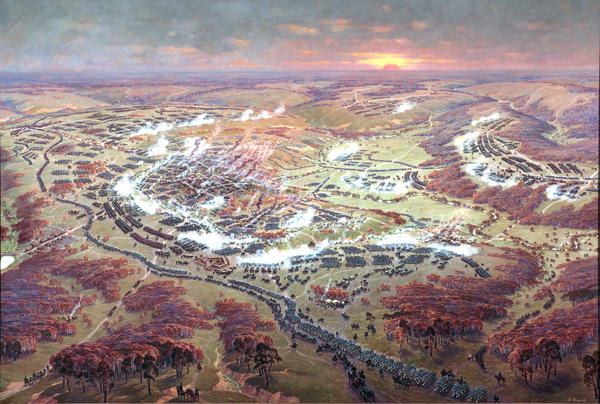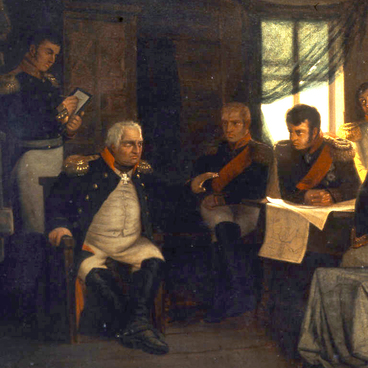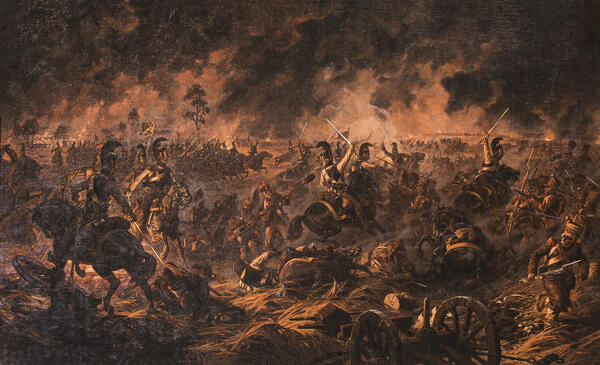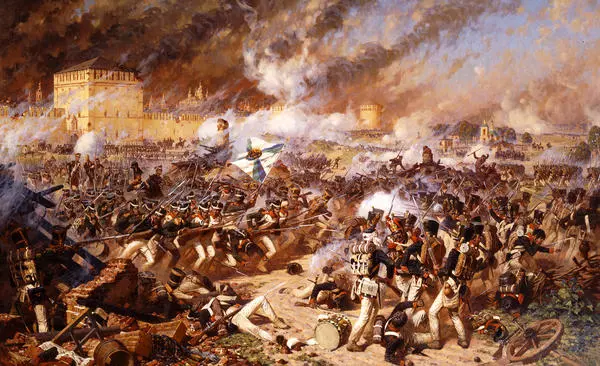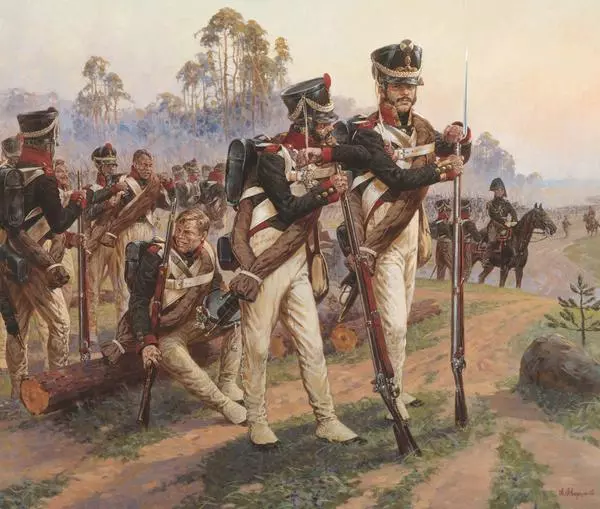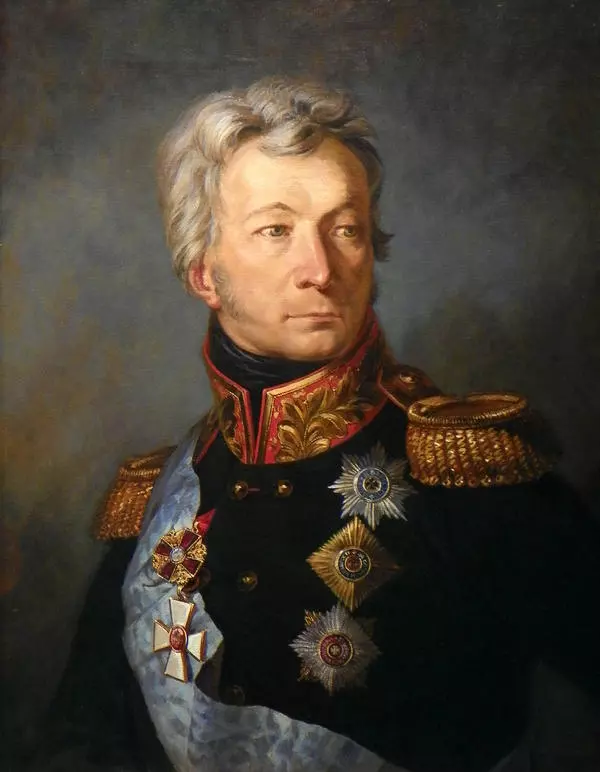In October 1812, after departure from burned Moscow, Napoleon decided to retreat in Smolensk direction through the Southern provinces of Russia. He hoped to replenish food and war reserve stock and to start another military campaign next year.
Maloyaroslavets was a small chief town of a district in the Kaluga Province. In 1812, there were about 200 houses and 1500 inhabitants there. The artist showed a bird’s eye panorama of an episode of the battle for Maloyaroslavets corresponding to the situation approximately at five o’clock in the evening on 12 (24 old style) October 1812.
The battle, which started before dawn, does not subside. Soldiers from the Corps of Eugène de Beauharnais, Napoleon’s stepson, seized the center of Maloyaroslavets. There are already about 60 thousand people in the streets of the burning city, hand-to-hand fights would not stop. Especially violent fighting rages on the Cathedral Square.
The main Russian forces besieged the city in a semicircle. At the West and South-West end of the city, the battle is conducted by regiments of the 26th and 27th infantry divisions under the command of Major Generals Ivan Paskevich and Dmitry Neverovsky. At the forefront, on the right, from the direction of Tarutino village, the troops of General Mikhail Miloradovich are approaching. The main task was to keep the enemy within the burning city, not giving it any chance to advance in the Kaluga direction (on the painting — on the left).
Napoleon’s main forces lined up behind the Luzha River — in the distant view on the right. Infantry divisions from the Corps of Marshal Louis-Nicolas Davout are getting ready to provide reinforcement for the Corps of Beauharnais which has lost a lot of strength.
The hill in the right part of the painting is Bunina Mountain. From there, for the whole day, Napoleon with his suite has been watching the course of the battle. Next to him, the troops of the Great Army cavalry reserve stationed themselves, and at the bottom of the mountain, Beauharnais’ Corps cavalry settled down. The matter was that the river high banks, winding roads and the city narrow streets were very uncomfortable for horses. Neither Russian, nor French cavalry took part in the battle.
On the upland on the opposite side, at the most important point near the road to Kaluga, Russian Armies Commander-in-Chief Mikhail Kutuzov with his staff took stand. The Russian troops cover the road safely from both sides.
At a distance, one can hardly see the troops of the 6th Infantry Corps of General of Infantry Dmitry Dokhturov. They were in action from the very morning and are resting now near the village of Terentyevo. Next to them, a cavalry from the detachment of Major General Ivan Dorokhov stationed itself. On the right, apart from others, Hetman of the Don Cossack Host Matvey Platov concentrated his troops.
After the sunset, the battle still continued for a few hours. In the end, the French and Italian troops managed to consolidate their positions in Maloyaroslavets. Though, the city itself did not exist anymore: only scorched ruins remained, piled with the bodies of killed and burned alive soldiers of both the armies.
The Russians thoroughly blocked all roads going out of the city, except one. The one along which the French troops had to retreat. Instead of rich, untouched by the war lands, they found devastated fields, villages and settlements that burned still in the summer. The battle for Maloyaroslavets marked the beginning of Napoleon’s Great Army final ruin.
Maloyaroslavets was a small chief town of a district in the Kaluga Province. In 1812, there were about 200 houses and 1500 inhabitants there. The artist showed a bird’s eye panorama of an episode of the battle for Maloyaroslavets corresponding to the situation approximately at five o’clock in the evening on 12 (24 old style) October 1812.
The battle, which started before dawn, does not subside. Soldiers from the Corps of Eugène de Beauharnais, Napoleon’s stepson, seized the center of Maloyaroslavets. There are already about 60 thousand people in the streets of the burning city, hand-to-hand fights would not stop. Especially violent fighting rages on the Cathedral Square.
The main Russian forces besieged the city in a semicircle. At the West and South-West end of the city, the battle is conducted by regiments of the 26th and 27th infantry divisions under the command of Major Generals Ivan Paskevich and Dmitry Neverovsky. At the forefront, on the right, from the direction of Tarutino village, the troops of General Mikhail Miloradovich are approaching. The main task was to keep the enemy within the burning city, not giving it any chance to advance in the Kaluga direction (on the painting — on the left).
Napoleon’s main forces lined up behind the Luzha River — in the distant view on the right. Infantry divisions from the Corps of Marshal Louis-Nicolas Davout are getting ready to provide reinforcement for the Corps of Beauharnais which has lost a lot of strength.
The hill in the right part of the painting is Bunina Mountain. From there, for the whole day, Napoleon with his suite has been watching the course of the battle. Next to him, the troops of the Great Army cavalry reserve stationed themselves, and at the bottom of the mountain, Beauharnais’ Corps cavalry settled down. The matter was that the river high banks, winding roads and the city narrow streets were very uncomfortable for horses. Neither Russian, nor French cavalry took part in the battle.
On the upland on the opposite side, at the most important point near the road to Kaluga, Russian Armies Commander-in-Chief Mikhail Kutuzov with his staff took stand. The Russian troops cover the road safely from both sides.
At a distance, one can hardly see the troops of the 6th Infantry Corps of General of Infantry Dmitry Dokhturov. They were in action from the very morning and are resting now near the village of Terentyevo. Next to them, a cavalry from the detachment of Major General Ivan Dorokhov stationed itself. On the right, apart from others, Hetman of the Don Cossack Host Matvey Platov concentrated his troops.
After the sunset, the battle still continued for a few hours. In the end, the French and Italian troops managed to consolidate their positions in Maloyaroslavets. Though, the city itself did not exist anymore: only scorched ruins remained, piled with the bodies of killed and burned alive soldiers of both the armies.
The Russians thoroughly blocked all roads going out of the city, except one. The one along which the French troops had to retreat. Instead of rich, untouched by the war lands, they found devastated fields, villages and settlements that burned still in the summer. The battle for Maloyaroslavets marked the beginning of Napoleon’s Great Army final ruin.

